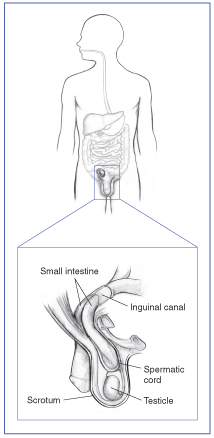by Marius Hinneh & Anthony Taylor; Farnsley Middle School (Louisville, KY)
One morning I [Marius, one of the co-authors] woke up with a burning pain near my waist. Later that day, when I coughed, sneezed or ran, it began to hurt more. At track practice, my coach noticed that I was limping while running and wanted me to see the doctor. A few days later, I went to the hospital for a checkup and my doctor diagnosed me with inguinal hernia.

According to the Mayo Clinic, an inguinal hernia is when a soft tissue pushes through a weak spot in your groin muscle, which causes a bulge in the groin scrotum—a pouch of skin containing the testicles—and it may hurt or burn. Marius’ doctor said that I would need to have surgery; but my parents couldn’t afford to take me to the hospital for my surgery.
“I was very lucky not to have surgery because the pain has gone away,” recalls Marius
According to WebMD, hernias begin when the body part of the muscle near the affected area, presses through the weak spot to a connected tissue called fascia –the sheath fibrous tissue enclosing a muscle. The most common types of hernia are inguinal (the inner groin in your body), incisional (the result from incision), femoral (the outer groin in your body), umbilical (belly button), and hiatal (upper stomach). They are all caused by a combination of the pressure and the weakness of the muscle. Sometimes the hernia is present at birth and other times it occurs later in life.
The common symptoms of hernias are bulging, limping and discomfort. It usually increases in size over time and usually disappears while lying down. Sometimes, the hernia comes without any warning and the hernia is discovered during a medical examination, according to Healthline, a medical website.
According to VoxHealth, a website that provides information about medical issues or diseases, hernias can happened at any age, but usually occur over the age of 40. Men are more affected with inguinal hernias because of the way the testicles form, moving down the inguinal canal and creating gaps in the abdominal muscle after birth. Women are more affected by femoral hernias because they have an opening in the bone structure of the female pelvis.
Whether you need a treatment depends on the size of your hernia and the severity of the symptoms. There is medication or surgery, but the most common is surgery. If the hernia gets bigger, larger, or causing pain, a doctor may repair your hernia by sewing the hole in the abdominal wall. The doctor can patch the hole with a surgical mesh, which provides additional support to weakened or damaged tissue, but costs a lot of money, according to Dr. Jenny Löfgren a researcher at Umeå University Department of Surgical and Perioperative Sciences in Umeå, Sweden.
“The traditional way of repairing hernia is to close the hole using sutures [stitches], but the risk of recurrence (the hernia reappears) is quite large as the sutures put a lot of strain on the tissues of the abdominal wall which is often weak,” Dr. Löfgren explained, in an email to SciJouner. “With a mesh, the tissues are not forced together and it is called a ‘non tension technique’. The risk of recurrence is much lower than with the sutured methods. This is why using a mesh is advisable in adults (but not in children).”
Since children are not allowed to have mesh for surgery, I am very lucky because the pain that I have been going through for three years has gone away.
Marius Hinneh Anthony Taylor

This work is licensed under a Creative Commons Attribution-NonCommercial-NoDerivs 3.0 Unported License














Good article.
Omg that’s my bestfriend you go Mari:smile:smile:smile:smile
Thanks Ann :smile
Really good article, you can tell how hard you must’ve worked.